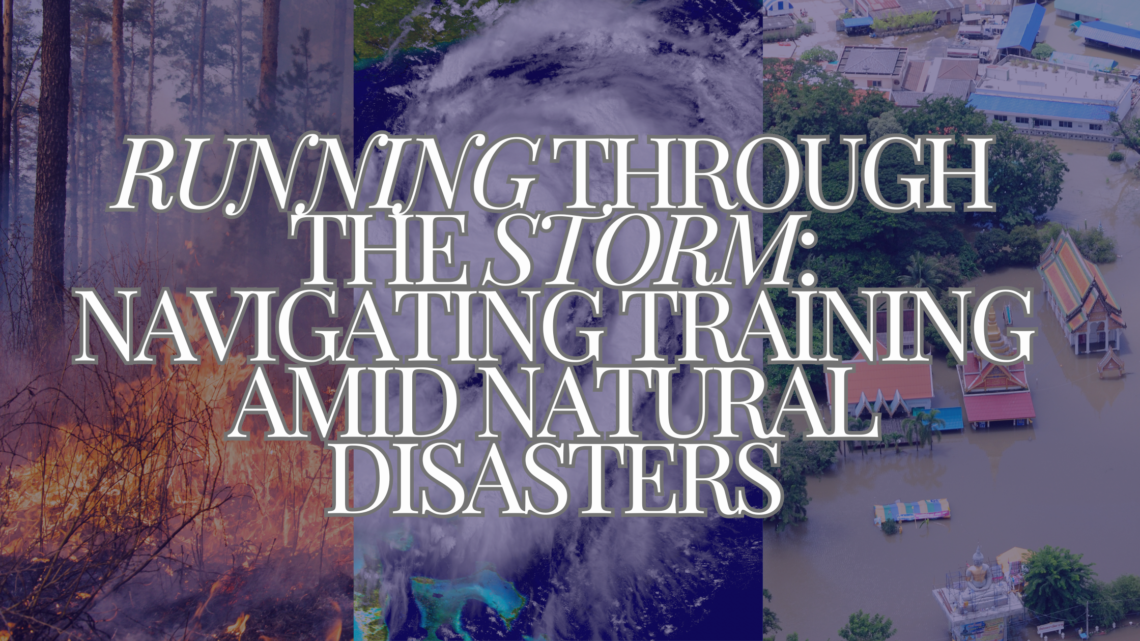Training for a half-marathon or marathon is already a journey of perseverance, discipline, and mental toughness. But when life throws an unexpected event like a natural disaster—whether it’s a hurricane, wildfire, flood, or other crisis—it can feel like everything you’ve worked for is at risk. Your daily routine gets upended, stress levels skyrocket, and running may be the last thing on your mind as you prioritize safety and recovery.
As a coach, my first and foremost message to you is this: your well-being and safety are the top priorities, always. Your running and racing goals may be important, but in the face of a natural disaster, flexibility and self-compassion are essential. You can get back on track with training—even if it means recalibrating your plans. Here’s a guide to help you prepare before a disaster, stay safe during, and rebuild your training after the storm.
Before the Disaster: Preparing for the Unexpected
You may not always have much notice before a natural disaster strikes, but when you do, it’s helpful to take proactive steps that allow for flexibility in your training without losing momentum completely. Here are a few strategies to help you prepare:
- Have a Contingency Plan
In regions prone to natural disasters, it’s a good idea to have a backup plan for your training. This includes knowing:- Indoor options like a treadmill, home-based workouts, or gym access (if safe).
- Altering routes to avoid flood zones or areas likely to be impacted.
- Time adjustments for runs—getting them done earlier if severe weather is expected later in the day.
- Stock Up on Essentials
If you’re preparing for a storm or power outage, make sure to have:- Hydration and nutrition essentials. Stock up on sports drinks, gels, snacks, and non-perishables that can fuel you if fresh food becomes unavailable.
- Rechargeable or battery-powered headlamps and gear in case power goes out, and you still want to run safely at home or in safe areas.
- Charging your smartwatches, headphones, and battery banks ahead of power outages is essential. Or this may
- Mentally Prepare for Flexibility
Understanding that things might not go according to plan is crucial. Be mentally flexible, ready to adapt your training when necessary, and avoid setting rigid expectations about how your training should look. This can help reduce frustration and disappointment when disruptions inevitably occur.
During the Disaster: Prioritizing Safety and Self-Care
When disaster strikes, the first and only priority is staying safe. Whether you’re evacuating or hunkering down, training can (and should) take a backseat. However, there are still small things you can do to stay engaged and ready to resume training when it’s safe.
- Shelter and Safety First
Your safety and the safety of your loved ones always come first. Don’t worry about missing a long run or tempo workout when you’re in the middle of a crisis. This isn’t the time to push through or take risks for the sake of your training plan. - Adapt with At-Home Workouts
If the weather or circumstances prevent you from running outdoors but conditions indoors are safe, consider alternative workouts:- Bodyweight exercises: Incorporate strength and mobility exercises like squats, lunges, planks, and core work to maintain strength.
- Cardio at home: Jumping jacks, stair climbs, or even running in place can help keep you moving.
- Yoga and stretching: Use this time to focus on flexibility and stress relief. Many online platforms offer guided yoga sessions that don’t require any equipment.
- Stay Mentally Grounded
Disasters are stressful, and that stress can take a toll on both your mental and physical health. During this time, it’s crucial to engage in activities that reduce stress, like:- Mindfulness or meditation: Take a few minutes each day to breathe deeply and center yourself. Apps like Calm or Headspace can be helpful.
- Journaling: Writing down your thoughts and fears can help alleviate anxiety and bring clarity. You can also use this time to reflect on your running goals and how to stay resilient through challenges.
- Hydration and Nutrition
Your normal hydration and nutrition routines may be disrupted during a disaster. Focus on keeping up your water intake and eating balanced meals where possible. This will support both your recovery and your return to training.
After the Disaster: Rebuilding Your Training
Once the immediate danger has passed and your environment begins to stabilize, the thought of getting back to training may feel overwhelming. It’s important to approach this phase with patience, allowing your body and mind to recover while you rebuild your fitness.
- Assess Your Current Situation
- Is it safe to run outside? Check the condition of your usual running routes. Are the roads clear of debris, and is the air quality good if you’ve been affected by smoke from wildfires?
- What resources do you have? If your gym or local running routes aren’t accessible, look into alternative options like parks, or consider sticking to indoor training for a bit longer.
- Prioritize Recovery
Stress, lack of sleep, and possible dehydration or poor nutrition during the disaster can have lingering effects. Don’t expect to jump back into your usual running schedule immediately. Start with:- Easy, low-intensity runs: Shorter, easy runs can help you ease back into the routine without overwhelming your body.
- Recovery days: Schedule more recovery days than you normally would in the immediate aftermath to allow your body to adapt.
- Rest and sleep: Prioritize sleep as a means of recovery. Your body heals and rebuilds strength during rest, so don’t underestimate its importance.
- Modify Your Training Plan
Depending on how much training time you’ve missed, you may need to adjust your goals and timeline. This is where communication with your coach is vital. If you’re self-coaching, here are some steps you can take:- Shorten or skip the taper period: If your race is near, you might shorten your taper or even eliminate it, depending on how much base fitness you’ve retained.
- Focus on quality over quantity: If your schedule is compressed, prioritize key workouts—like long runs or tempo runs—over trying to catch up on every missed session.
- Be kind to yourself: Accept that your race goal might shift from achieving a PR to simply finishing strong. Adjust your expectations and be proud of the resilience it took to continue.
- Lean on Your Support System
Whether it’s fellow runners, family, or your coach, lean on your support network during this rebuilding phase. Running communities are known for their strength and camaraderie, and this is a time when encouragement and shared experience can make a huge difference.
Rebuilding After Major Setbacks: Getting Back on Track Long-Term
If you’ve been severely impacted and have missed several weeks of training, you may need to rebuild from the ground up. This is perfectly okay! Remember, half-marathon and marathon training are not about perfection—it’s about persistence.
- Return to Basics
Start with rebuilding your aerobic base. Incorporate more low-intensity running, gradually increasing your mileage over the course of several weeks. Pay close attention to how your body feels and avoid the temptation to rush back to high mileage. - Reassess Your Race Goals
Depending on how much training time was lost, you may need to reassess your race goals. This could mean aiming to finish the marathon comfortably rather than hitting a specific time goal. Alternatively, you may decide to push back your race plans to give yourself more time to train. - Stay Positive and Patient
Rebuilding can be frustrating, but it’s also an opportunity to strengthen your mental resilience. Celebrate small wins along the way—whether it’s completing your first post-disaster long run or simply finding the energy to lace up your shoes after everything you’ve been through.
Moving Forward: Strength and Resilience Through Adversity
Training for a goal race is about so much more than just race day. It’s about the journey, the lessons learned along the way, and the mental toughness gained through pushing beyond obstacles—both expected and unexpected. Natural disasters are life-altering events, but they also give us the chance to prove our resilience and adaptability.
If you’ve been impacted by a natural disaster, know that it’s okay for your training to look different. It’s okay to slow down, to change your goals, and to take time for recovery. Ultimately, the strength you gain from overcoming these challenges will make you a better runner and person in the long run.
Stay safe, stay strong, and remember: No storm, no wildfire, no flood can take away the determination and spirit that drives you toward your goals. When you’re ready, I’ll be here to help guide you back onto the path—one step at a time.
Need Support?
If you’re currently dealing with the aftermath of a natural disaster and need personalized guidance or adjustments to your training plan, reach out. As your coach, I’m here to help you recover, rebuild, and continue chasing your running dreams.


Lots of good info. Having lived thru and lost a home to wildfire was tough. Still keep my emergency box with important stuff ready to go and even put tornado shelter in the house we just built. Dealing now with my training after my half got cancelled this weekend. Man, I was ready but now have to regroup and figure out my next move. Looking forward to listening to podcast
Oh goodness, Jane, I am so sorry that your half marathon was cancelled. While we logically comprehend the reasons why they elect to cancel races due to natural disasters and the need to prioritize resources, it can still be emotionally devastating after a season of dedicated training. Sending you lots of love!
Jane, thinking of you after all you’ve been through and still pushing forward.